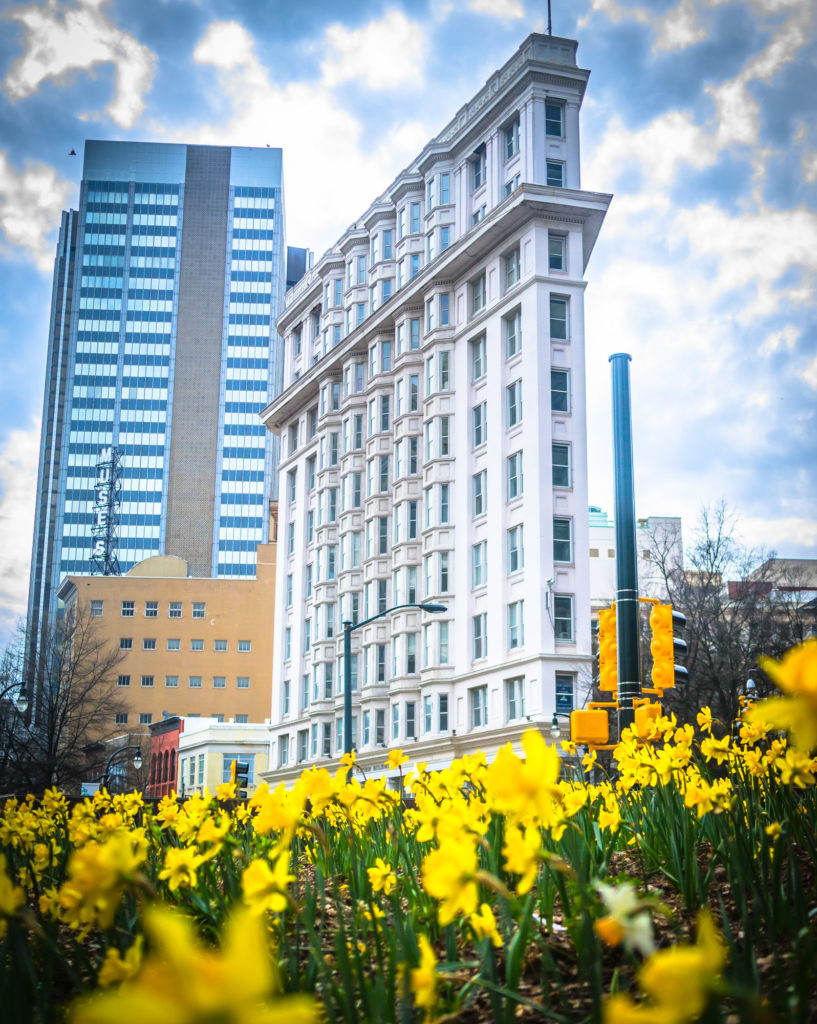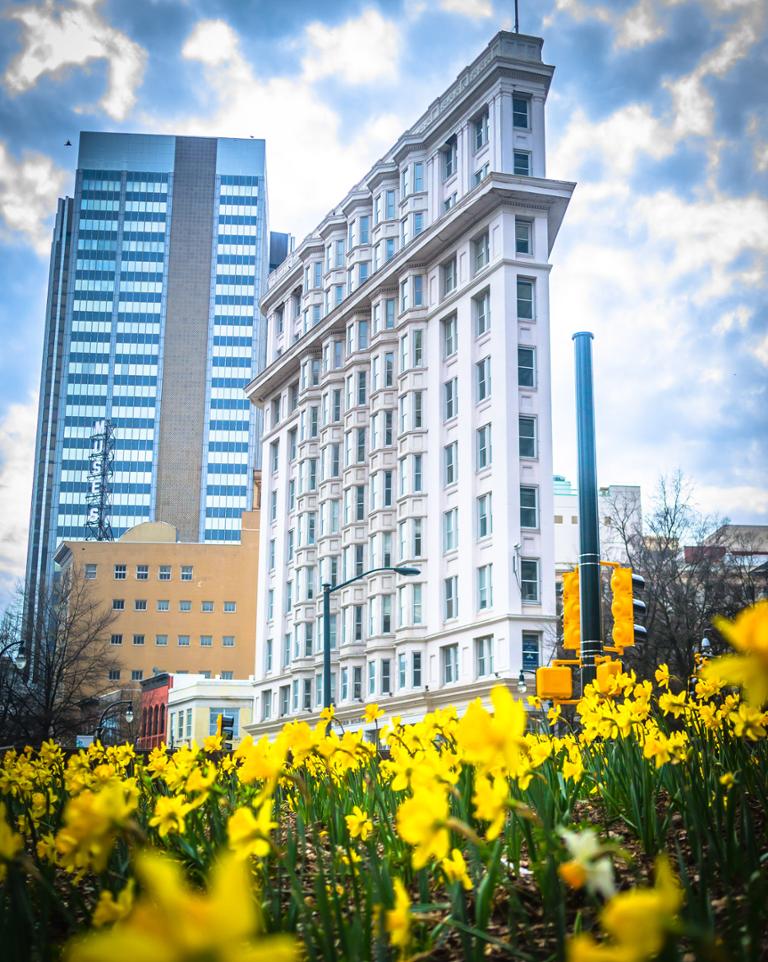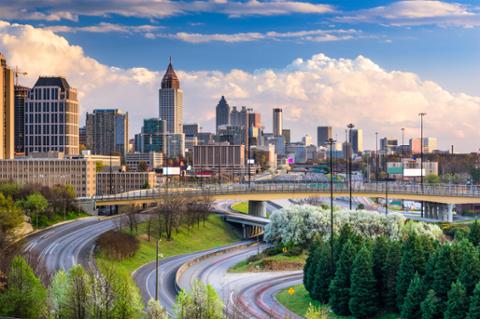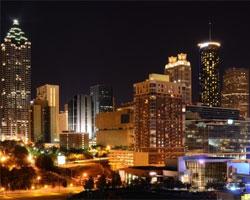 On a triangular site in the heart of downtown Atlanta, a 120-year-old landmark is helping establish the city’s tech future. Opened in 1897, Atlanta’s oldest standing skyscraper is now dubbed “FlatironCity.” It’s a 40,000 square-foot, 10-story triangle rising in a narrow wedge between Broad and Peachtree Streets. The building’s renovation and regeneration was made possible through a public-private partnership that included Atlanta's Economic Development Authority, Invest Atlanta, and J.P. Morgan Chase. Those companies worked with Lucror Resources to revamp the building; in September, the restoration was awarded Project of the Year 2017 from the Urban Land Institute (ULI). The refurbished office building houses a diverse tenant base, including the Women’s Entrepreneurship Initiative (WEI), an incubator for women founded companies, and B2B startups serving the airline, logistics, chemical/refinery, digital advertising and music industries. The skyscraper also houses flexible co-working spaces. In December 2015, it became home to Microsoft’s second U.S.-based Microsoft Innovation Center (MIC). Ian Philpot, a Microsoft senior software engineer who works at FlatironCity, said the building’s atypical, dynamic space was part of the appeal. “We want people who are working on highly innovative products to enjoy a space that fosters creativity,” he explained. “The people there are also very forward-thinking, so we’ve seen that having our teams work in these types of environments fosters growth, and they’re typically more happy than in your typical cubicle farm.” Philip takes pride in knowing his grandmother—one of the first women professors at Georgia State—used to have an office there in the 1970s. “It’s the oldest skyscraper in Atlanta,” he said. “I don’t know the complete history of the building but I know it’s steeped in history. When I walk in, I really feel like they did a great job keeping that historic feel to it but modernizing it.” FlatironCity boasts a 2Gbps fiber optic pipe with a building-exclusive Web connection, as well as access to premarket technology such as the HoloLens and SurfaceHub. Conference rooms include wireless presentation screens. “Part of the partnership we have with Flatiron was bringing a lot of Microsoft technology into the building, like digital signage, which we custom-built, [and] a small maker space, so if we have to do some 3D printing or prototype something with Raspberry Pi boards, we can do that,” Philpot noted. The building’s amenities go beyond tech components: in an effort to lure desirable Millennial entrepreneurs, FlatironCity offers on-site bike storage, a shower facility and lockers, and weekly events such as yoga and happy hours. Sonia Sequeira, FlatironCity’s community development manager, told Dice that a major component of the venture was honoring the history of the building—which has always contained offices—while looking toward the future. “This is the area where Martin Luther King, Jr. lived, this is the most historic part of our city. When people are working here, it’s helping push Atlanta forward,” she said. “This is in the heart of downtown Atlanta—unlike other cities, downtown is on the verge of a renaissance but we’re not there yet.” Sequeira noted there were some major challenges in retrofitting the building to meet the needs of 21st century tech entrepreneurs, such as providing 25 access points for the high-speed fiber optic—a hefty figure for a building of just 40,000 square feet. “This building was built with Carnegie steel, which doesn’t exactly go hand-in-hand with a fiber optic line,” she explained. “The elevator—which we have since replaced—used to be slow, we only have one staircase—I’m the first one anyone comes to with these issues—but this is something that we need to do more often; orient historic buildings toward the future.” She said part of her goal is to raise the profile not only of the building as a place of business but of the building’s contribution to architectural history and development. "I always tell my boss I want this building to become an icon like the [Flatiron] in New York—our building actually pre-dates that building by four years,” Sequeira said. “This is about being a part of recreating the urban fabric of downtown Atlanta.” The big hope is that FlatironCity will propel startup growth. “Maybe someone starts off with a single desk and an idea, and they grow into a suite, then half a floor and eventually a whole floor,” Sequeira said. “It’s really cool when companies come downtown, commit to downtown, and grow here.” Azim Barodawala, CEO of Volantio, a company that helps airlines maximize unit revenues and decrease costs through greater capacity utilization, said he fell in love the building the minute he saw it during a Metro Atlanta Chamber tour of the city. “We saw it and thought it looks so cool from the outside, it felt to us like the kind of place that our team would want to come to work, and that was really important,” he said. “We also saw the opportunity that we could start in a small office and grow into something that could be a bit bigger.” Barodawala pointed to the vibrancy of the neighborhood, the building’s location between two MARTA rapid transit stations, bike storage with showers (nearly half of their employees bike or take MARTA to work), and views of the park and capital building as important elements of what makes the building more than just another start-up incubator. "The community is really great—Sonia is awesome and really cares about everyone in the building,” he said. “It’s so important to everyone to have a sense of community in the building, and I think about what it would be like to work if that wasn’t there… and where else are you going to get a building where can you have bay windows on three different sides of the same office?”
On a triangular site in the heart of downtown Atlanta, a 120-year-old landmark is helping establish the city’s tech future. Opened in 1897, Atlanta’s oldest standing skyscraper is now dubbed “FlatironCity.” It’s a 40,000 square-foot, 10-story triangle rising in a narrow wedge between Broad and Peachtree Streets. The building’s renovation and regeneration was made possible through a public-private partnership that included Atlanta's Economic Development Authority, Invest Atlanta, and J.P. Morgan Chase. Those companies worked with Lucror Resources to revamp the building; in September, the restoration was awarded Project of the Year 2017 from the Urban Land Institute (ULI). The refurbished office building houses a diverse tenant base, including the Women’s Entrepreneurship Initiative (WEI), an incubator for women founded companies, and B2B startups serving the airline, logistics, chemical/refinery, digital advertising and music industries. The skyscraper also houses flexible co-working spaces. In December 2015, it became home to Microsoft’s second U.S.-based Microsoft Innovation Center (MIC). Ian Philpot, a Microsoft senior software engineer who works at FlatironCity, said the building’s atypical, dynamic space was part of the appeal. “We want people who are working on highly innovative products to enjoy a space that fosters creativity,” he explained. “The people there are also very forward-thinking, so we’ve seen that having our teams work in these types of environments fosters growth, and they’re typically more happy than in your typical cubicle farm.” Philip takes pride in knowing his grandmother—one of the first women professors at Georgia State—used to have an office there in the 1970s. “It’s the oldest skyscraper in Atlanta,” he said. “I don’t know the complete history of the building but I know it’s steeped in history. When I walk in, I really feel like they did a great job keeping that historic feel to it but modernizing it.” FlatironCity boasts a 2Gbps fiber optic pipe with a building-exclusive Web connection, as well as access to premarket technology such as the HoloLens and SurfaceHub. Conference rooms include wireless presentation screens. “Part of the partnership we have with Flatiron was bringing a lot of Microsoft technology into the building, like digital signage, which we custom-built, [and] a small maker space, so if we have to do some 3D printing or prototype something with Raspberry Pi boards, we can do that,” Philpot noted. The building’s amenities go beyond tech components: in an effort to lure desirable Millennial entrepreneurs, FlatironCity offers on-site bike storage, a shower facility and lockers, and weekly events such as yoga and happy hours. Sonia Sequeira, FlatironCity’s community development manager, told Dice that a major component of the venture was honoring the history of the building—which has always contained offices—while looking toward the future. “This is the area where Martin Luther King, Jr. lived, this is the most historic part of our city. When people are working here, it’s helping push Atlanta forward,” she said. “This is in the heart of downtown Atlanta—unlike other cities, downtown is on the verge of a renaissance but we’re not there yet.” Sequeira noted there were some major challenges in retrofitting the building to meet the needs of 21st century tech entrepreneurs, such as providing 25 access points for the high-speed fiber optic—a hefty figure for a building of just 40,000 square feet. “This building was built with Carnegie steel, which doesn’t exactly go hand-in-hand with a fiber optic line,” she explained. “The elevator—which we have since replaced—used to be slow, we only have one staircase—I’m the first one anyone comes to with these issues—but this is something that we need to do more often; orient historic buildings toward the future.” She said part of her goal is to raise the profile not only of the building as a place of business but of the building’s contribution to architectural history and development. "I always tell my boss I want this building to become an icon like the [Flatiron] in New York—our building actually pre-dates that building by four years,” Sequeira said. “This is about being a part of recreating the urban fabric of downtown Atlanta.” The big hope is that FlatironCity will propel startup growth. “Maybe someone starts off with a single desk and an idea, and they grow into a suite, then half a floor and eventually a whole floor,” Sequeira said. “It’s really cool when companies come downtown, commit to downtown, and grow here.” Azim Barodawala, CEO of Volantio, a company that helps airlines maximize unit revenues and decrease costs through greater capacity utilization, said he fell in love the building the minute he saw it during a Metro Atlanta Chamber tour of the city. “We saw it and thought it looks so cool from the outside, it felt to us like the kind of place that our team would want to come to work, and that was really important,” he said. “We also saw the opportunity that we could start in a small office and grow into something that could be a bit bigger.” Barodawala pointed to the vibrancy of the neighborhood, the building’s location between two MARTA rapid transit stations, bike storage with showers (nearly half of their employees bike or take MARTA to work), and views of the park and capital building as important elements of what makes the building more than just another start-up incubator. "The community is really great—Sonia is awesome and really cares about everyone in the building,” he said. “It’s so important to everyone to have a sense of community in the building, and I think about what it would be like to work if that wasn’t there… and where else are you going to get a building where can you have bay windows on three different sides of the same office?” Historic Atlanta Skyscraper Transforms Into Tech Incubator
 On a triangular site in the heart of downtown Atlanta, a 120-year-old landmark is helping establish the city’s tech future. Opened in 1897, Atlanta’s oldest standing skyscraper is now dubbed “FlatironCity.” It’s a 40,000 square-foot, 10-story triangle rising in a narrow wedge between Broad and Peachtree Streets. The building’s renovation and regeneration was made possible through a public-private partnership that included Atlanta's Economic Development Authority, Invest Atlanta, and J.P. Morgan Chase. Those companies worked with Lucror Resources to revamp the building; in September, the restoration was awarded Project of the Year 2017 from the Urban Land Institute (ULI). The refurbished office building houses a diverse tenant base, including the Women’s Entrepreneurship Initiative (WEI), an incubator for women founded companies, and B2B startups serving the airline, logistics, chemical/refinery, digital advertising and music industries. The skyscraper also houses flexible co-working spaces. In December 2015, it became home to Microsoft’s second U.S.-based Microsoft Innovation Center (MIC). Ian Philpot, a Microsoft senior software engineer who works at FlatironCity, said the building’s atypical, dynamic space was part of the appeal. “We want people who are working on highly innovative products to enjoy a space that fosters creativity,” he explained. “The people there are also very forward-thinking, so we’ve seen that having our teams work in these types of environments fosters growth, and they’re typically more happy than in your typical cubicle farm.” Philip takes pride in knowing his grandmother—one of the first women professors at Georgia State—used to have an office there in the 1970s. “It’s the oldest skyscraper in Atlanta,” he said. “I don’t know the complete history of the building but I know it’s steeped in history. When I walk in, I really feel like they did a great job keeping that historic feel to it but modernizing it.” FlatironCity boasts a 2Gbps fiber optic pipe with a building-exclusive Web connection, as well as access to premarket technology such as the HoloLens and SurfaceHub. Conference rooms include wireless presentation screens. “Part of the partnership we have with Flatiron was bringing a lot of Microsoft technology into the building, like digital signage, which we custom-built, [and] a small maker space, so if we have to do some 3D printing or prototype something with Raspberry Pi boards, we can do that,” Philpot noted. The building’s amenities go beyond tech components: in an effort to lure desirable Millennial entrepreneurs, FlatironCity offers on-site bike storage, a shower facility and lockers, and weekly events such as yoga and happy hours. Sonia Sequeira, FlatironCity’s community development manager, told Dice that a major component of the venture was honoring the history of the building—which has always contained offices—while looking toward the future. “This is the area where Martin Luther King, Jr. lived, this is the most historic part of our city. When people are working here, it’s helping push Atlanta forward,” she said. “This is in the heart of downtown Atlanta—unlike other cities, downtown is on the verge of a renaissance but we’re not there yet.” Sequeira noted there were some major challenges in retrofitting the building to meet the needs of 21st century tech entrepreneurs, such as providing 25 access points for the high-speed fiber optic—a hefty figure for a building of just 40,000 square feet. “This building was built with Carnegie steel, which doesn’t exactly go hand-in-hand with a fiber optic line,” she explained. “The elevator—which we have since replaced—used to be slow, we only have one staircase—I’m the first one anyone comes to with these issues—but this is something that we need to do more often; orient historic buildings toward the future.” She said part of her goal is to raise the profile not only of the building as a place of business but of the building’s contribution to architectural history and development. "I always tell my boss I want this building to become an icon like the [Flatiron] in New York—our building actually pre-dates that building by four years,” Sequeira said. “This is about being a part of recreating the urban fabric of downtown Atlanta.” The big hope is that FlatironCity will propel startup growth. “Maybe someone starts off with a single desk and an idea, and they grow into a suite, then half a floor and eventually a whole floor,” Sequeira said. “It’s really cool when companies come downtown, commit to downtown, and grow here.” Azim Barodawala, CEO of Volantio, a company that helps airlines maximize unit revenues and decrease costs through greater capacity utilization, said he fell in love the building the minute he saw it during a Metro Atlanta Chamber tour of the city. “We saw it and thought it looks so cool from the outside, it felt to us like the kind of place that our team would want to come to work, and that was really important,” he said. “We also saw the opportunity that we could start in a small office and grow into something that could be a bit bigger.” Barodawala pointed to the vibrancy of the neighborhood, the building’s location between two MARTA rapid transit stations, bike storage with showers (nearly half of their employees bike or take MARTA to work), and views of the park and capital building as important elements of what makes the building more than just another start-up incubator. "The community is really great—Sonia is awesome and really cares about everyone in the building,” he said. “It’s so important to everyone to have a sense of community in the building, and I think about what it would be like to work if that wasn’t there… and where else are you going to get a building where can you have bay windows on three different sides of the same office?”
On a triangular site in the heart of downtown Atlanta, a 120-year-old landmark is helping establish the city’s tech future. Opened in 1897, Atlanta’s oldest standing skyscraper is now dubbed “FlatironCity.” It’s a 40,000 square-foot, 10-story triangle rising in a narrow wedge between Broad and Peachtree Streets. The building’s renovation and regeneration was made possible through a public-private partnership that included Atlanta's Economic Development Authority, Invest Atlanta, and J.P. Morgan Chase. Those companies worked with Lucror Resources to revamp the building; in September, the restoration was awarded Project of the Year 2017 from the Urban Land Institute (ULI). The refurbished office building houses a diverse tenant base, including the Women’s Entrepreneurship Initiative (WEI), an incubator for women founded companies, and B2B startups serving the airline, logistics, chemical/refinery, digital advertising and music industries. The skyscraper also houses flexible co-working spaces. In December 2015, it became home to Microsoft’s second U.S.-based Microsoft Innovation Center (MIC). Ian Philpot, a Microsoft senior software engineer who works at FlatironCity, said the building’s atypical, dynamic space was part of the appeal. “We want people who are working on highly innovative products to enjoy a space that fosters creativity,” he explained. “The people there are also very forward-thinking, so we’ve seen that having our teams work in these types of environments fosters growth, and they’re typically more happy than in your typical cubicle farm.” Philip takes pride in knowing his grandmother—one of the first women professors at Georgia State—used to have an office there in the 1970s. “It’s the oldest skyscraper in Atlanta,” he said. “I don’t know the complete history of the building but I know it’s steeped in history. When I walk in, I really feel like they did a great job keeping that historic feel to it but modernizing it.” FlatironCity boasts a 2Gbps fiber optic pipe with a building-exclusive Web connection, as well as access to premarket technology such as the HoloLens and SurfaceHub. Conference rooms include wireless presentation screens. “Part of the partnership we have with Flatiron was bringing a lot of Microsoft technology into the building, like digital signage, which we custom-built, [and] a small maker space, so if we have to do some 3D printing or prototype something with Raspberry Pi boards, we can do that,” Philpot noted. The building’s amenities go beyond tech components: in an effort to lure desirable Millennial entrepreneurs, FlatironCity offers on-site bike storage, a shower facility and lockers, and weekly events such as yoga and happy hours. Sonia Sequeira, FlatironCity’s community development manager, told Dice that a major component of the venture was honoring the history of the building—which has always contained offices—while looking toward the future. “This is the area where Martin Luther King, Jr. lived, this is the most historic part of our city. When people are working here, it’s helping push Atlanta forward,” she said. “This is in the heart of downtown Atlanta—unlike other cities, downtown is on the verge of a renaissance but we’re not there yet.” Sequeira noted there were some major challenges in retrofitting the building to meet the needs of 21st century tech entrepreneurs, such as providing 25 access points for the high-speed fiber optic—a hefty figure for a building of just 40,000 square feet. “This building was built with Carnegie steel, which doesn’t exactly go hand-in-hand with a fiber optic line,” she explained. “The elevator—which we have since replaced—used to be slow, we only have one staircase—I’m the first one anyone comes to with these issues—but this is something that we need to do more often; orient historic buildings toward the future.” She said part of her goal is to raise the profile not only of the building as a place of business but of the building’s contribution to architectural history and development. "I always tell my boss I want this building to become an icon like the [Flatiron] in New York—our building actually pre-dates that building by four years,” Sequeira said. “This is about being a part of recreating the urban fabric of downtown Atlanta.” The big hope is that FlatironCity will propel startup growth. “Maybe someone starts off with a single desk and an idea, and they grow into a suite, then half a floor and eventually a whole floor,” Sequeira said. “It’s really cool when companies come downtown, commit to downtown, and grow here.” Azim Barodawala, CEO of Volantio, a company that helps airlines maximize unit revenues and decrease costs through greater capacity utilization, said he fell in love the building the minute he saw it during a Metro Atlanta Chamber tour of the city. “We saw it and thought it looks so cool from the outside, it felt to us like the kind of place that our team would want to come to work, and that was really important,” he said. “We also saw the opportunity that we could start in a small office and grow into something that could be a bit bigger.” Barodawala pointed to the vibrancy of the neighborhood, the building’s location between two MARTA rapid transit stations, bike storage with showers (nearly half of their employees bike or take MARTA to work), and views of the park and capital building as important elements of what makes the building more than just another start-up incubator. "The community is really great—Sonia is awesome and really cares about everyone in the building,” he said. “It’s so important to everyone to have a sense of community in the building, and I think about what it would be like to work if that wasn’t there… and where else are you going to get a building where can you have bay windows on three different sides of the same office?” 


